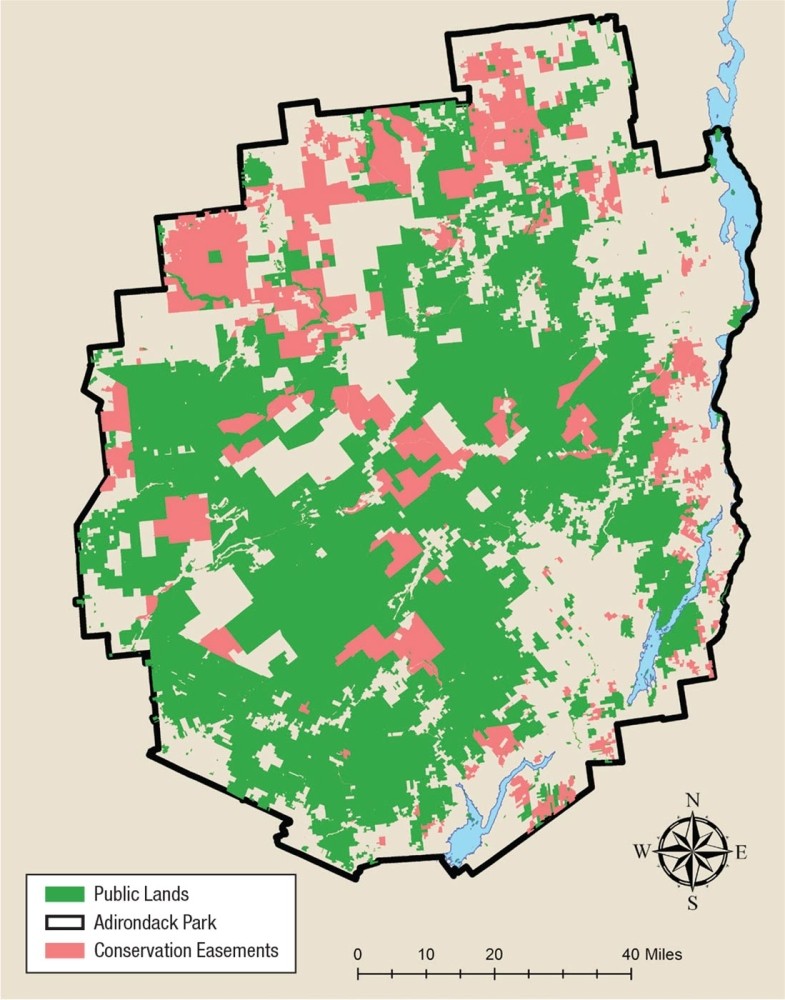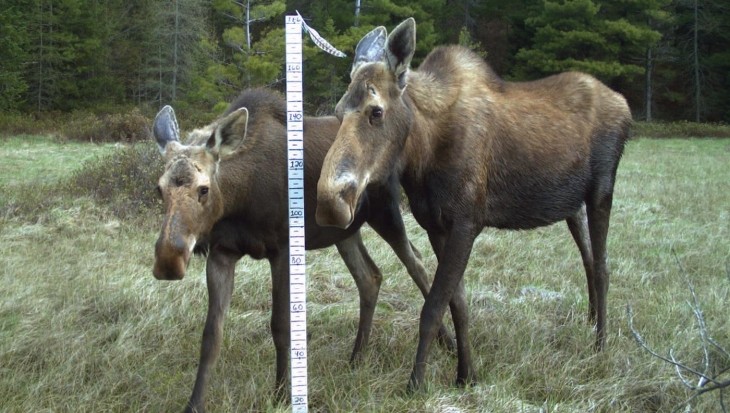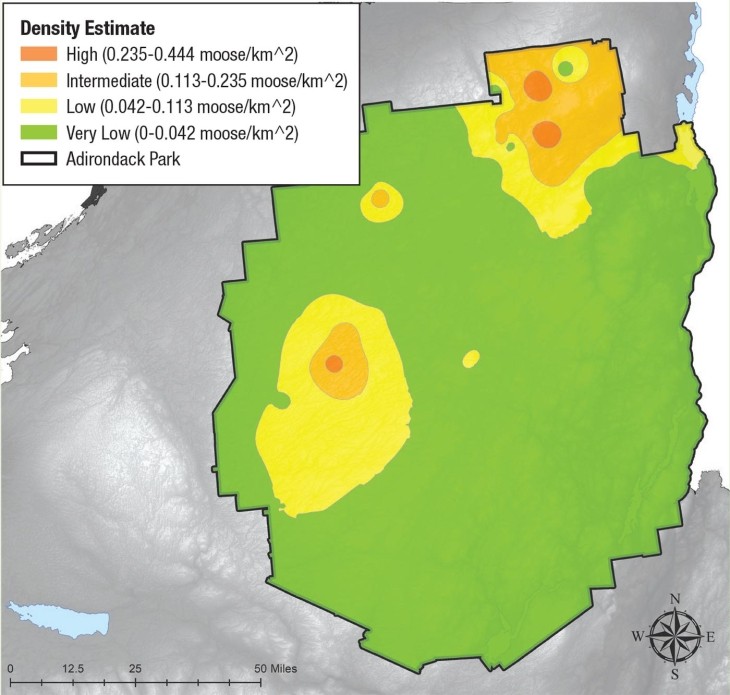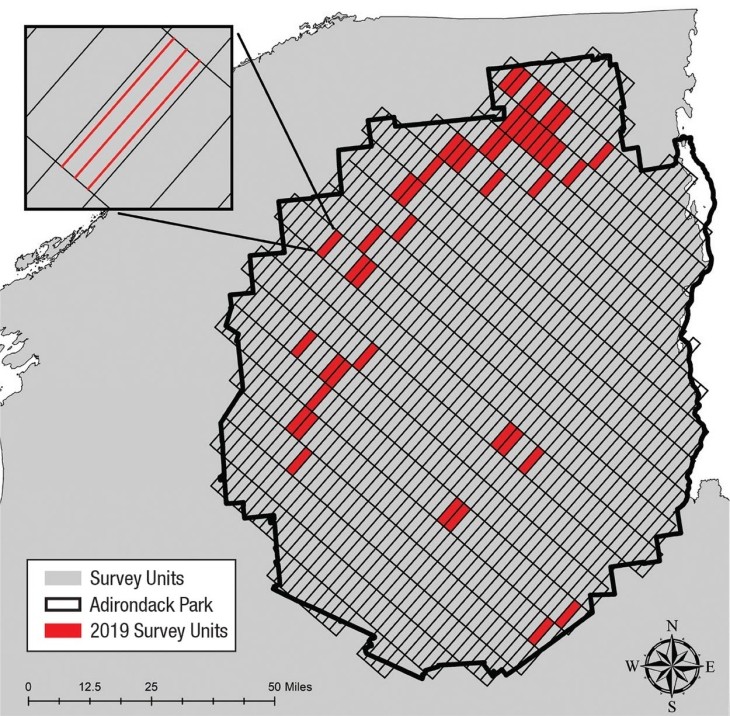
By the mid-1800s, loss of forests to agricultural land and hunting had extirpated moose throughout much of the Northeast. With the reversion of large tracts of farmland to forest during the second half of the 20th century, moose slowly began to move south again from their stronghold in Maine, including into New York State. Today, there are established breeding populations of moose in the Taconic Highlands and the Catskill and Adirondack regions.
In 2015, the New York State Department of Environmental Conservation (NYSDEC) launched a collaborative study to gather information about moose health and population, and to help the state answer important questions related to moose management. Participants include researchers from Cornell University, SUNY-ESF, the Biodiversity Research Institute, and the Wildlife Conservation Society - Adirondack Program.
The team has focused its work on Adirondack Park, which hosts the most moose in the state. One question that the team is attempting to answer is why the state’s moose population (currently estimated to be between 700 and 800 animals) is not growing.
Jen Grauer, a PhD student at Cornell University, is investigating factors that may be contributing to population stagnation, including high mortality among calves. Moose calves are especially vulnerable to disease during their first year, and previous studies in Maine revealed that in that state, parasites such as winter ticks were the leading cause of death for moose less than one year old. Unlike deer and caribou, moose don’t remove ticks by grooming, and mass tick infestations can cause significant blood loss and debilitation. Brainworm and liver fluke, two parasites that moose may contract when they eat infected slugs or snails, may also contribute significantly to calf mortality.
This past winter, Grauer and the team searched for juvenile moose by helicopter, flushing them from the woods to open areas where they were safely captured with a net gun. The team blindfolded each moose to calm it, and quickly got to work collecting measurements and samples, a delicate operation for an animal that at one year old can weigh up to 600 pounds. Researchers applied a GPS collar and took a blood sample, a fecal sample, and a tissue punch from an ear. They also checked for external parasites and symptoms of internal parasites.
The team tracks juveniles for two and a half years, or until a GPS collar emits an alert that the animal has been sedentary for more than six hours, a sign that it has probably died. To date, researchers have conducted nearly 200 necropsies of moose (all ages), mainly in the Adirondacks, to determine the cause of death.
The team also collects deer pellets and water samples from an area of approximately 1,000 square kilometers in the northern area of the park near Saranac Lake and Lake Placid (where the highest density of moose have been recorded). These are tested for the presence of parasites. In fall, researchers download photos from a network of trail cameras, which can help estimate deer density and their territorial overlap with the local moose population, a factor in parasite transfer.

Grauer hopes that the data will show if correlations exist between moose survival numbers and year-to-year parasite abundance, or will show the prevalence of their larvae on the landscape. She also speculates that increasingly warmer temperatures – particularly later autumn frosts – are contributing to greater survival of winter tick nymphs. SUNY-ESF researchers on the team have noted an increase in tick numbers in Adirondack forests during the past several years; sampling from 2015 to 2017 found little evidence of ticks, but they were prevalent in 2021.
Work by Grauer and her colleagues provides critical baseline information for future management decisions, explains NYSDEC Research Scientist David Kramer. Using data collected to date, NYSDEC is drafting a population status plan for moose. However, the work of NYSDEC and its partners to “put together the moose puzzle,” as Kramer describes it, is complicated by the state’s constitutional ban on timber removal from state-owned lands in Adirondack Park. Moose thrive in young forests where they can feed on abundant buds and saplings, and aging forests can reduce their food supply. In the park, as an experiment to promote moose numbers, the NYSDEC has started timber cutting projects on several privately held tracts that it co-manages under conservation easements.



